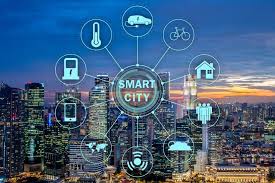WHAT IS SMART CITY DEVELOPMENT?
A Smart city is an urban area that uses different types of electronic Internet of things sensors to collect data and then use insights gained from that data to manage assets, resources and services efficiently. This includes data collected from citizens, devices, and assets that is processed and analyzed to monitor and manage traffic and transportation systems, power plants, utilities, water supply networks, waste management, crime detection information systems, schools, libraries, hospitals, and other community services.
In a simpler sense, a smart city is a municipality that uses information and communication technologies (ICT) to increase operational efficiency, share information with the public and improve both the quality of government services to her citizens.
The Smart Cities Mission, aims to develop the entire urban eco-system, represented by the four pillars of comprehensive development, institutional, physical, social and economic infrastructure.
The concept integrates information and communication technology , and various physical devices connected to the ICT network to optimize the efficiency of city operations and services and connect to citizens. Smart city technology allows city officials to interact directly with both community and city infrastructure in the bid to monitor what is happening in the city and how the city is evolving.
It is worthy to note, that ICT is used to enhance quality, performance and interactivity of urban services, to reduce costs and resource consumption and to increase contact between citizens and government. Smart city applications are developed to manage urban flows and allow for real-time responses.
A Smart city may therefore be more prepared to respond to challenges than one with a simple “transactional” relationship with its citizens. Yet, the term itself remains unclear to its specifics and therefore, open to many interpretations.
Major technological, economic and environmental changes have generated interest in smart cities, including climate change, economic restructuring, the move to online retail and entertainment, ageing populations, urban population growth and pressures on public finances.
However, The European Union has devoted constant efforts to devising a strategy for achieving ‘smart’ urban growth for its metropolitan city-regions. The EU has developed a range of programmes under ‘Europe’s Digital Agenda”.
A good number of Smart city technologies and programs have been implemented in Singapore, India, Dubai,Milton Keynes, Southampton,Amsterdam,Barcelona, Madrid, Stockholm, Copenhagen, China, and New York.
Smart city initiatives have measurable positive impacts on the quality of life of its citizens and visitors. The human framework of a Smart city its economy, knowledge networks, and human support systems is an important indicator of its success.
It employs a combination of data collection, processing, and disseminating technologies in conjunction with networking and computing technologies and data security as well as privacy measures encouraging the application of innovation to promote the overall quality of life for its citizens and covering dimensions that include: utilities, health, transportation, entertainment and government services.
Electronic cards (known as smart cards) are another common platform in Smart city contexts. These cards possess a unique encrypted identifier that allows the owner to log into a range of government provided services (or e-services) without setting up multiple accounts. The single identifier allows governments to aggregate data about citizens and their preferences to improve the provision of services and to determine common interests of groups.

Leave a comment



